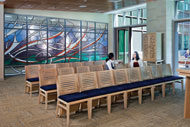 |
| Studying Abroad By Amy Eagle Writing on the Wall By Amy Eagle |
It’s not just the economy that has gone global. America’s health care design community increasingly is taking its talents overseas to assist in hospital construction and renovation projects everywhere on the globe.
This trend is interesting not just for the expertise domestic architects and interior designers are lending to overseas health care projects, but also for the lessons U.S. designers are learning while working abroad.
In our lead article in this installment of Interiors, author Amy Eagle shares what American designers have learned from their international work. Sensitivities honed through working in different cultures can help to shape and expand design perspectives while influencing the selection of flooring materials, furniture, amenities and how these design elements relate to the patient experience. Throughout this report, you’ll find images illustrating some of the latest design trends abroad. You’ll also see that the focus on reducing construction costs and shortening the time to building completion are every bit as important elsewhere in the world as here.
Our second report in this edition examines the rapidly changing field of digital signage and why many hospitals are embracing this technology to improve everything from patient satisfaction to finding prominent ways to recognize hospital donors.
Some hospitals and health systems are leveraging digital signage to produce 3-D wayfinding maps and are able to issue real-time emergency alerts and notifications. Some organizations are also integrating applications like Facebook and SharePoint into communication strategies to get their messages to the right people at the right time. Others are using digital kiosks to provide live video communications with an expert in the facility such as a pharmacist who can answer questions about over-the-counter drug interactions.
These and other creative solutions are helping hospitals to maintain a high-service, high-touch relationship even when the hospital staff member isn’t physically within reach.
A note of acknowledgment
The editors thank the many vendors and health care design firms who participated in this supplement. The following sources provided images used in this project:
• HDR (San Francisco)
• HKS (Indianapolis)
• Planar Systems Inc. (Beaverton, Ore.)
• Rise Vision (Ontario, Canada)
• X20 Media Inc. (Quebec, Canada)
• Nationwide Children’s Hospital (Columbus, Ohio)
ON THE COVER // Royal Children’s Hospital, Melbourne Australia. Photo courtesy of Billard Leece, Bates Smart and HKS Inc. Above: King Fahad Medical City, Saudi Arabia. Rendering courtesy of HKS.





